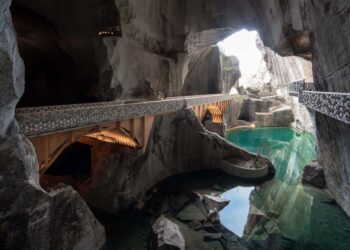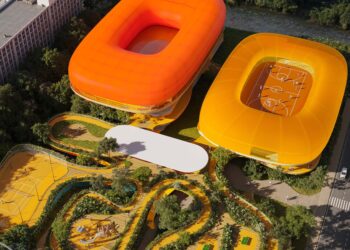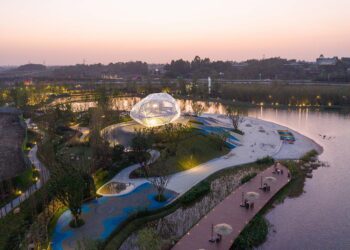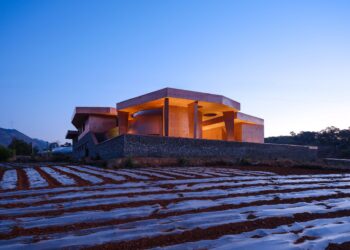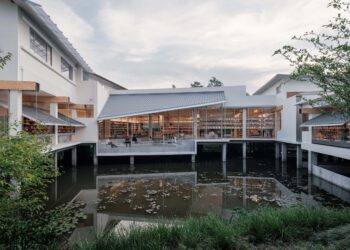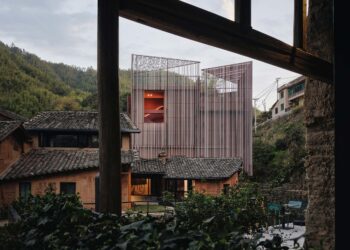Reminiscent of a well-spring harmoniously combining water, greenery and light in its circular form
하늘, 빛, 그림자, 물소리와 어우러진 샘물
CROX
Chengdu Science and Technology Industry Incubation Park is located in the Core Area of Tianfu New District, a certified National Economic and Technological Development Zone in China, with an overall planning area of 330,000m2. It is now home to over 240 science technology and health enterprises, including many of the world top 500 companies. To foster health-tech companies, the park hopes to build landmark buildings, which lead the new mode of incubation industry and economy.
청두 과학 기술 산업 육성 공원은 중국 티안푸 신도시 중심부에 자리한다. 이 지역은 중국 국가 경제 및 기술 발전 지구로, 전체면적이 33만m2에 달한다. 현재 240개가 넘는 과학 기술 업체와 건강 기업이 입주해 있으며, 그중에는 세계 상위 500위권에 드는 회사도 있다.
공원 입구에서 멀지 않은 곳에 문화센터가 들어섰다. 새로운 산업과 경제 요람을 이끌 공원의 랜드마크이자, 동서부 기업을 연결하는 소통 공간이다.
Project: Longquan Well-Chengdu Jingkai White Building / Location: Chengdu, China / Architecture, landscape design: CROX / Design team: Lin Congran, Zhou Tianye, Sun Lidong, Ni Guoyue, Zhu Jiayi, Li Bangle, Zhu Jinhui, Lin Sen, Li Bentao, Ye Xiunan, Zhuang Xueyan, Zhang Mingzheng, Pan Tianyi / Working drawing design partner: Sichuan zhongheng architectural design co., ltd. / Construction: Sichuan No.3 Construction Co., Ltd. / Client: hengdu Jingkai Technology Industry Incubation Co., Ltd. / Landscape area: 3,633m2 / Ground floor area: 1,034m2 / Underground area: 700m2 / Materials: cement, glass, green plants, stone, lighting, metal / Completion: 2020.4 / Photograph: Li Guomin
Harmonious Environment
According to the needs of the park, the purpose is to connect eastern and western health industries, forming a communicative space that transforms the existing artificial site into a sustainable and ecological environment. The land extends from northeast to southwest. In the landscape design, the designers have extracted the flowing water lines and reshaped them into a more natural formation.
On the main entrance square of Chenglong Avenue, a series of hills serve to streamline the flow of traffic, standing like outstretched hands. The ups and downs of the terrain filters the noise on the roads and the winding lane restricts the traffic speed, making the visit more pleasurable. The masterplanning of the pedestrian areas is considered alongside the separation of vehicles, so the parking lot is on the lower ground and the design of the pedestrian walkways extends from large ladders through the landscape to the inner space.
The atrium is a multi-point layout of alluvial fans, forming mound-shaped planting platforms in different sizes. It provides a multi-functional social space for people to gather and communicate.
건축주는 기존 인공 지반이 지속 가능하고 자연과 어우러지는 환경으로 바뀌길 원했다. 건축가는 북동쪽에서 남서쪽으로 확장된 부지에 물줄기를 형성한 뒤, 이를 더 자연에 가까운 형태로 다듬었다.
건물 앞 청룽 대로로 나가는 광장에는 작은 언덕이 쫙 편 두 손처럼 늘어서 있다. 울룩불룩한 지형은 도로 소음을 차단하고, 구불구불한 찻길은 차량 속도를 낮춘다. 낮은 땅에 배치된 주차장 덕에 보행로는 차와 분리된다. 드넓은 계단에서 시작해 아트리움을 지나 실내 공간으로 이어지는 동선은 방문자들에게 즐거움을 준다.
Water-like Spirit
Old Chengdu was once a city of water, historically criss-crossed by canals and ditches, bridges and pools. At present, places have gone and only several names are remembered. In the words of architect C.R. Lin: “Watery Chengdu is a dreamy scenery that even a land was named as Lingquan (a spiritual well) since ancient times. Buildings are like spring wells that gushed out, linking the ancient times with today.”
Not far from the entrance is a small building with a white façade with drop-shaped windows arranged organically, which twinkle in the sunlight. The half-moon pool forms a waterfall, generating the constant sound of running water. The semi-circular gate and the circular platform also echo this metaphor of a moon reflected in the water. Arriving at the inner atrium, a large oval pool appears, reflecting the skylight onto surrounding curved glass windows and leaving an unfilled scene on the white wall. Light penetrates through the leaves of green bamboo, its shadows waving and dancing. The hollow part of the white building is reserved for the sky and earth, reproducing the mysterious realm with changes of light and shadow.
오래전 청두는 물의 도시였다. 심지어 땅 이름이 고대부터 ‘영적 우물’이란 뜻을 가진 ‘룽취안’이었을 정도다. 역사적으로 보면 운하와 수로, 교각과 웅덩이가 날실과 씨실처럼 교차했지만, 오늘날 그런 장소는 모두 사라지고 이름만이 몇 곳 남았다.
건축가는 꿈에 그리던 물이 많은 청두를 샘물 같은 건물로 표현했다. 유기적으로 배열된 물방울 모양 창문은 햇빛 속에서 반짝이고, 건물을 감싼 반달 모양 연못은 끊임없이 흐르는 물소리를 낸다. 입구의 반원형 문과 원형 기단은 물에 비친 달이라는 은유를 담는다. 안으로 들어서면 하늘로 열린 아트리움이 맞이하고, 가운데엔 타원형 연못이 있다. 하늘이 물에 반사되어 주변 곡선 유리창에 비치고 흰 벽에도 희미한 잔상을 남긴다. 연못 중앙의 대나무 이파리 사이로 빛이 관통하면 그림자가 물결치며 춤춘다. 끊임없이 변하는 빛과 그림자는 텅 빈 공간에 신비로운 왕국을 재현한다.
Architectural atmosphere
The cultural center is given a vibrant dynamic texture, in the prototype of the circular building. Through the formation of circles, a multi-level spatial space achieves a coherent exterior and interior experience. This is an open space for people come in and out, the arched wall and skylight, giving a light and transparent feeling.
The surrounding space integrates leisure, exhibition, conference, reception and office facilities. The horizontal external window allows for the adjustment of both light and temperature, while the boundaries of the concrete structured space are blurred by large floor-to-ceiling windows. Green energy was considered in the design of the pool, whereby rainwater is collected which cools the building. These natural powers combine with architecture, turning it into a symbol to share with others.
건물의 둥그런 형태는 활기찬 느낌을 자아낸다. 포개진 원은 크기와 높이가 제각각인 공간을 이루고, 적절히 어우러진 실내와 실외는 방문객이 내외부를 골고루 느끼도록 한다.
아트리움을 둘러싼 건물은 전시, 회의, 사무 시설을 갖췄다. 외부 창은 빛과 온도 조절을 하고, 아치형 벽과 천창은 투명함을 강조한다. 바닥에서 천장까지 포물선을 그리는 거대한 창은 콘크리트 구조로 된 공간의 경계를 흐릿하게 만든다. 녹색 에너지를 고려한 연못은 빗물을 모아 건물 냉방에 쓴다. 자연이 가진 힘은 건축과 결합해 많은 이와 공유하는 상징이 된다.

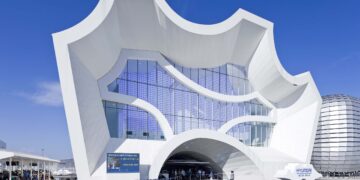
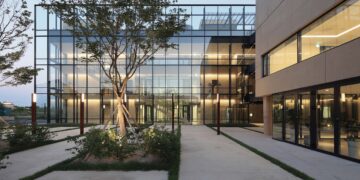
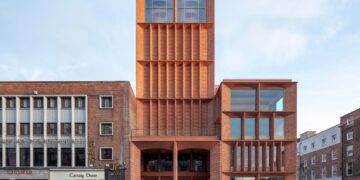
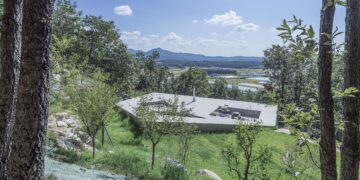

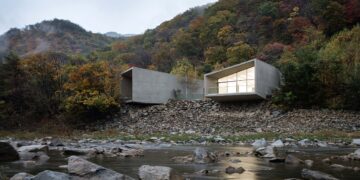
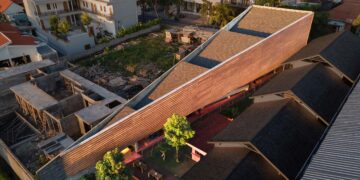

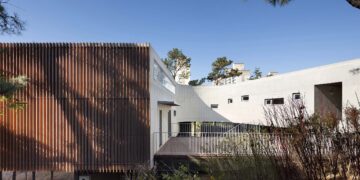
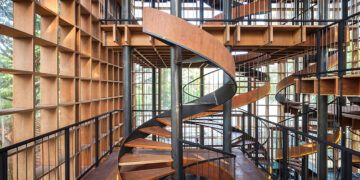
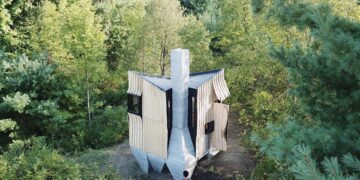




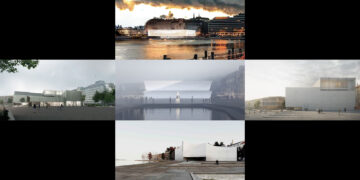
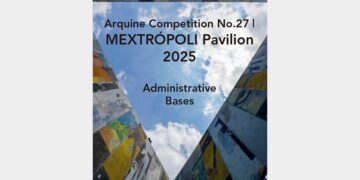
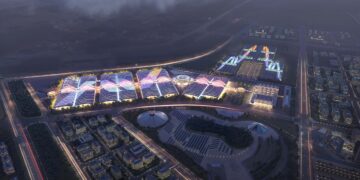
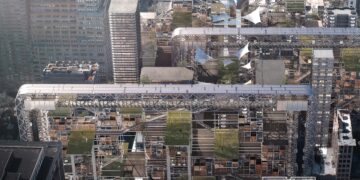
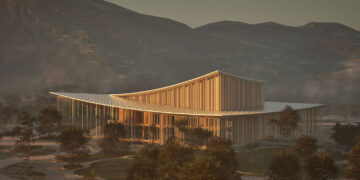


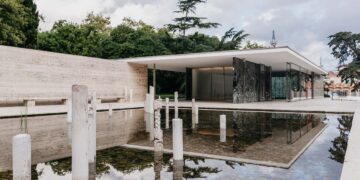
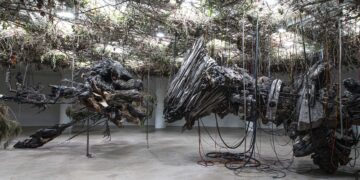
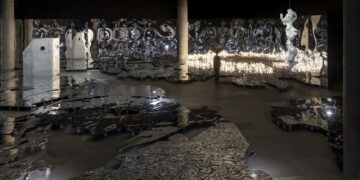

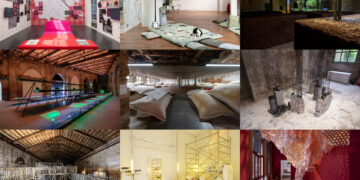






 …
…


















